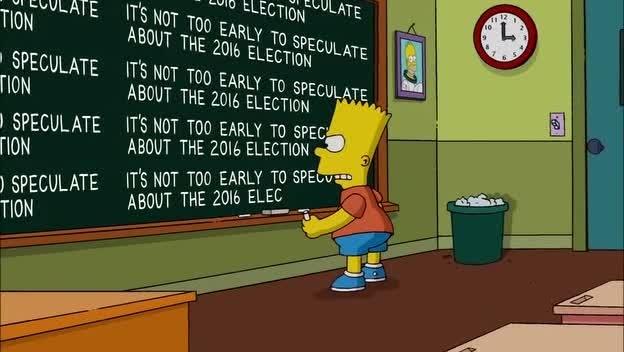
11 / 2016
Категорії: English language
The 2016 presidential election has certainly given us a lot to talk about, including actual words used by the candidates themselves. As we run up to the big day on November 8, here’s a look back at some of the buzzwords the campaign and candidates have given us—and a look into their surprising histories.

1. RIGGED
Many candidates and voters have expressed their frustration with the establishment because they feel the political and economic system is rigged against them. The word rigged has nothing to do with any ship of state, so to speak. In the 17th century, a rig was a colloquial term for a “scheme,” “prank,” or “swindle,” like the thimblerig, an early shell game. Some etymologists think this rig comes from the phrase to play rex, “to act like a lord or master.” Such is the power, apparently, that trickery can endow. By the 1820 and ’30s, rigged auctionswere huckstering shabby wares and rigged stocks were illegally manipulating their values, both of which anticipate today’s use of rigged.
2. QUAGMIRE
Throughout his campaign, Bernie Sanders described geopolitical situations in the Middle East as quagmires. But back in the 1560s, a quagmire was far from the desert terrain we associate with that region: It was wet, boggy land. The word probably literally means “marsh marsh,” joining quag, a variant of quab (of obscure origin) and mire (from Old Norse). Sanders didn’t employ a new metaphor, though, with his quagmire: The word has referred to “sticky situations” since the 1570s.
3. BOMBAST
Many pundits and critics have described Donald Trump’s style as bombastic. Bombast has characterized “inflated” language since the 1580s, describing speech that is “puffed up” like the cotton, once called bombast, that was used to pad or stuff clothing. The word traces back to the Latin (bombax) and Greek (bombyx) for a yet softer substance: silk.
4. STAMINA
Speaking of fibers, stamina—that “vigor” and “endurance” much discussed this year as a presidential qualification—comes from the Latin word stamen, meaning “thread.” In Roman textiles, the stamen was a specific kind of thread that served as a foundation for a weave. The Romans also used stamen for the “thread of life” spun by the Fates, whose mythical weaving determined how long humans lived.
Both senses of the Latin stamen, a foundational thread and one’s inborn longevity, came to influence the modern sense of stamina, which gradually emerges between 1500 and 1800 for the “essential qualities” that gives an organism its “energy” and “perseverance.” Note that qualities is plural, as is stamina in Latin. The stamen of a plant is also named for the “thread-like” shape of the organ.
5. ENDORSE
Heads aren’t the only body part of the 2016 road to the White House. Backs are, too. Many conservative newspapers made headlines by endorsing a Democrat—here, Hillary Clinton, of course—for the first time in their history. In the 1300s, to endorse was “to write on the back of” something, especially a financial document like a check. Endorsing a check serves as an act of verification. This notion of verification extended to “confirmation” or “approval” in the mid-1800s, hence political endorsements. At root is the Latin indorsare, joining in (on) and dorsum(back). Dorsum also yields do-si-do (via French dos-à- dos), which involves dancing “back to back.”
6. SHIMMY
No do-si-do has found the political spotlight this campaign (yet). But another dance, the shimmy, has, thanks to Hillary Clinton’s much-memed shoulder shaking in the first presidential debate. The shimmy started out as a popular (and often banned) jazz dance in the 1910s. Some etymologists think the shimmy shake comes from shimmy, an 1830s dialectical variant of chemise, historically a kind of smock or undergarment. The connection between the article of clothing and the dance move is uncertain.
7. PIVOT
The shimmy isn’t the only fancy maneuver of the election. After the candidates clinch their nominations, they pivot away from winning over their party base towards the general electorate. Back in the 14th century, a pivot was a “hinge pin,” the central rod around which some mechanism, like a pair of shears or scissors, rotates. And it’s this idea of a central point that leads to a word like pivotal in the early 1800s. Basketball players were pivoting by the late 1890s, whose quick turning on a pivot leads to the political pivot used by politicians today. The English pivot is from the French pivot, a word whose deeper origins are unclear.
8. CLINCH
And why are candidates said to clinch nominations? Because they settle the contest decisively, like a clinched nail. To clinch a nail is to hammer it through a board and bend back the point, which ensures it’s fastened. The verb appears by the 1570s, probably a variant form of clench. The sense of victory-securing clinching emerges in the 1700s. The root of clinchand clench is the same that gives English cling.
9. HOAX
In past tweets, Donald Trump has treated climate change as a hoax. The word hoax, a kind of elaborate or mischievous deception, turns up in the late 18th century and probably developed out of hocus, an older term for a “trick” a juggler would perform. In the early 1600s, a juggler, originally a jester or conjuror, could have gone by the nickname of Hocus Pocus.




